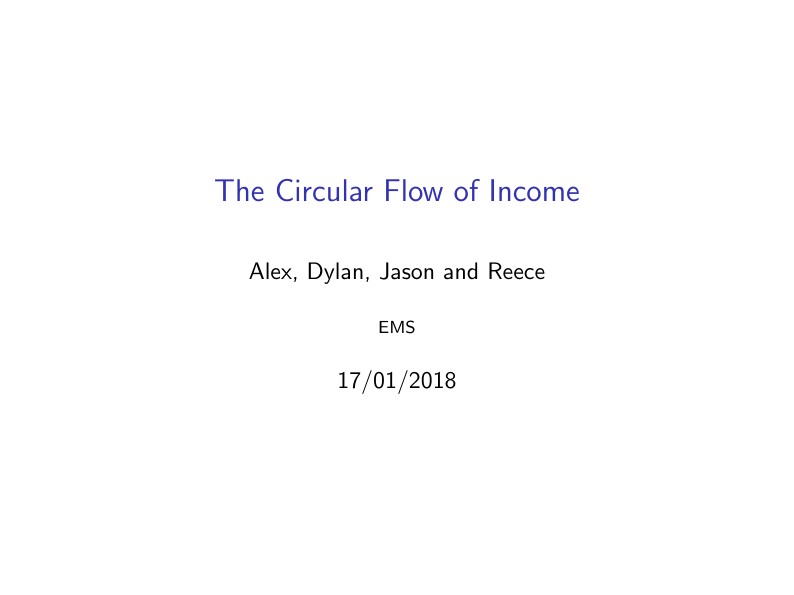
Economics
Autor:
Dylan Todd
Last Updated:
hace 8 años
License:
Creative Commons CC BY 4.0
Resumen:
The Circular Flow of Income

\begin
Discover why over 20 million people worldwide trust Overleaf with their work.
The Circular Flow of Income

\begin
Discover why over 20 million people worldwide trust Overleaf with their work.
\documentclass{beamer}
%
% Choose how your presentation looks.
%
% For more themes, color themes and font themes, see:
% http://deic.uab.es/~iblanes/beamer_gallery/index_by_theme.html
%
\mode<presentation>
{
\usetheme{default} % or try Darmstadt, Madrid, Warsaw, ...
\usecolortheme{default} % or try albatross, beaver, crane, ...
\usefonttheme{default} % or try serif, structurebold, ...
\setbeamertemplate{navigation symbols}{}
\setbeamertemplate{caption}[numbered]
}
\usepackage[english]{babel}
\usepackage[utf8x]{inputenc}
\title[Economics]{The Circular Flow of Income}
\author{Alex, Dylan, Jason and Reece}
\institute{EMS}
\date{17/01/2018}
\begin{document}
\begin{frame}
\titlepage
\end{frame}
% Uncomment these lines for an automatically generated outline.
%\begin{frame}{Outline}
% \tableofcontents
%\end{frame}
\section{Introduction}
\begin{frame}{The Circular Flow of Income}
\begin{itemize}
\item The Circular Flow of Income shows the flow of income through an economy, going between firms and households.
\end{itemize}
\vskip 1cm
\begin{figure}
\includegraphics[width=0.6\linewidth]{Circular_flow_of_goods_income.png}
\caption{A simple diagram outlining the main principles of the circular flow of
income}
\end{figure}
\end{frame}
\begin{frame}
\begin{itemize}
\item The economy can be split up into firms and households
\item Firms produce goods and services and the value of this is known as National Output.
\item Households purchase the goods and services that the firms provide. This is known as the National Expenditure.
\item Firms employ household members and pay them an income. This household income is used for spending.
\item Households also provide land, labour and capital for the firms.
\vskip 1cm
At full employment, \newline
National Output = National Income = National Expenditure
\end{itemize}
\end{frame}
\section{Some \LaTeX{} Examples}
\subsection{Tables and Figures}
\begin{frame}{Impacts of Injections and Withdrawals into the Circular Flow}
\begin{figure}
\includegraphics[width=0.85\linewidth]{circular1.jpg}
\caption{A diagram showing injections and withdrawals into the economy}
\end{figure}
% Commands to include a figure:
%\begin{figure}
%\includegraphics[width=\textwidth]{your-figure's-file-name}
%\caption{\label{fig:your-figure}Caption goes here.}
%\end{figure}
\end{frame}
\begin{frame}
\begin{itemize}
\item An injection into the circular flow of income is money into the economy. Injections come in the form of exports, investment and government spending.
\item A withdrawal into the circular flow of income is money going out of the economy. This is often in the form of imports, taxation and saving money.
\item These injections and withdrawals mean that money can be put into the circular flow of income, however it can also escape the flow (or leak).
\item If injections = withdrawals, the economy is in equilibrium.
\item Net injections result in a growth of the economy, whereas net withdrawals result in a contraction of the economy.
\end{itemize}
\end{frame}
\subsection{Mathematics}
\begin{frame}{The Multiplier Effect and its Impacts on the Economy}
\begin{figure}
\includegraphics[width=0.5\linewidth]{MultiplierEffect-infograph-large.png}
\caption{The multiplier effect shows how the value an initial injection into the circular flow can multiply. This means that the injection will be less than the change in national income.}
\end{figure}
\end{frame}
\begin{frame}
\begin{itemize}
\item The multiplier effect occurs when there is an increase in demand, and an injection into the economy occurs.
\item It shows how an increase in AD can result in a much larger increase in national income.
\item However, the size of the multiplier depends on the rate on withdrawals from the circular flow.
\end{itemize}
\begin{figure}
\includegraphics[width=0.5\linewidth]{multiplier-effect.jpg}
\caption{This figure shows how the multiplier effect can increase AD sometimes more than desired, resulting in inflation.}
\end{figure}
\end{frame}
\begin{frame}{The effects of Marginal Propensities on the Multiplier}
\begin{itemize}
\item The marginal propensity to consume (MPC) is the proportion of each additional pound in a household that is used for consumer spending rather than saving. The higher the MPC, the larger the size of the multiplier. MPC can be increased by governments by decreasing direct taxation, increasing the disposable income of the consumers.
\item The marginal propensity to save (MPS) is the opposite of MPC, and a consumer's MPC + MPS = 1
\item There is also the marginal propensity to tax (MPT) and the marginal propensity to import (MPM). MPT is based on how much tax will be required of each additional pound, and MPM shows how much consumers will spend on imports rather than domestic goods and services.
\item If MPT or MPM increase, this decreases the multiplier.
\end{itemize}
\end{frame}
\begin{frame}{Calculating the Multiplier}
\begin{itemize}
\item A formula that can be used to calculate the multiplier is
\vskip 0.8cm
$1/(1-MPC)$
\vskip 0.8cm
\item Since the marginal propensity to withdraw is shown by, \linebreak
\vskip 0.02cm
MPW = MPS + MPT + MPM \linebreak
\vskip 0.02cm
the multiplier can also be calculated by \linebreak
\vskip 0.02cm
$1/MPW$
\end{itemize}
\end{frame}
\end{document}